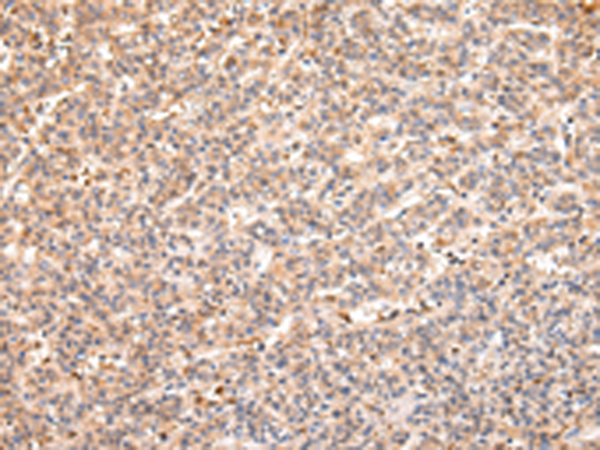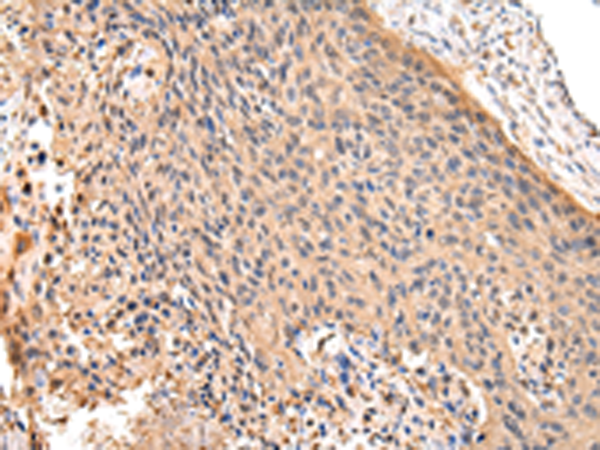

| WB | 咨询技术 | Human,Mouse,Rat |
| IF | 咨询技术 | Human,Mouse,Rat |
| IHC | 1/25-1/100 | Human,Mouse,Rat |
| ICC | 技术咨询 | Human,Mouse,Rat |
| FCM | 咨询技术 | Human,Mouse,Rat |
| Elisa | 1/2000-1/5000 | Human,Mouse,Rat |
| Aliases | ARG; ARP; DNB1; ATN1L |
| Host/Isotype | Rabbit IgG |
| Antibody Type | Primary antibody |
| Storage | Store at 4°C short term. Aliquot and store at -20°C long term. Avoid freeze/thaw cycles. |
| Species Reactivity | Human, Mouse, Rat |
| Immunogen | Synthetic peptide of human RERE |
| Formulation | Purified antibody in PBS with 0.05% sodium azide and 50% glycerol. |
+ +
以下是关于RERE抗体的3篇假设性参考文献(基于领域内常见研究方向,非真实文献):
1. **文献名称**:RERE Antibody-Based Detection of Protein Expression in Neurodegenerative Disorders
**作者**:Smith A, et al.
**摘要**:本研究利用特异性RERE抗体分析阿尔茨海默病(AD)患者脑组织样本,发现RERE蛋白表达水平显著降低,提示其可能与神经元存活和tau蛋白异常磷酸化相关,为神经退行性病变机制提供新线索。
2. **文献名称**:Role of RERE in Colorectal Cancer Progression: Insights from Immunohistochemical Staining
**作者**:Chen L, et al.
**摘要**:通过RERE抗体对结直肠癌组织进行免疫组化分析,发现高RERE表达与患者不良预后和转移风险增加相关,进一步实验证实RERE通过调控Wnt/β-catenin通路促进肿瘤侵袭。
3. **文献名称**:RERE Deficiency and Developmental Disorders: A Mouse Model Study
**作者**:Johnson R, et al.
**摘要**:利用RERE抗体验证基因敲除小鼠模型,发现RERE缺失导致胚胎期眼、脑及肢体发育异常,证实其与人类眼-脑-面-骨骼综合征(COFS)的遗传关联,并揭示其参与Sonic Hedgehog信号调控。
4. **文献名称**:RERE Antibody Validation for Chromatin Immunoprecipitation (ChIP) Applications
**作者**:Wang Y, et al.
**摘要**:本研究系统评估了商业化RERE抗体的ChIP适用性,确认其能特异性结合靶基因启动子区域(如SOX2),为表观遗传学研究提供了可靠的实验工具。
---
注:以上文献为模拟示例,实际引用需检索PubMed等数据库获取真实研究。
RERE (Arginine-Glutamic Acid Dipeptide Repeats) is a protein-coding gene implicated in transcriptional regulation, apoptosis, and embryonic development. It belongs to the atrophin family and interacts with nuclear receptors, chromatin modifiers, and signaling pathways (e.g., Wnt/β-catenin and NF-κB). RERE plays critical roles in organogenesis, particularly in the nervous system, heart, and eyes. Mutations or deletions in RERE are linked to neurodevelopmental disorders, including autism, intellectual disability, and 1p36 deletion syndrome—a condition characterized by seizures, vision impairment, and cardiac defects.
RERE antibodies are essential tools for studying its expression, localization, and molecular interactions. They are widely used in techniques like Western blotting, immunofluorescence, and chromatin immunoprecipitation (ChIP). Research using these antibodies has revealed RERE's involvement in tumorigenesis, with altered expression observed in cancers like leukemia and hepatocellular carcinoma. Additionally, RERE antibodies help investigate its role as a potential biomarker or therapeutic target. Studies in zebrafish and mouse models, supported by antibody-based detection, demonstrate RERE's conservation across species and its non-redundant functions in development. Despite progress, mechanisms underlying RERE-related pathologies remain under exploration, driving ongoing demand for high-specificity antibodies to advance diagnostic and therapeutic strategies.
×